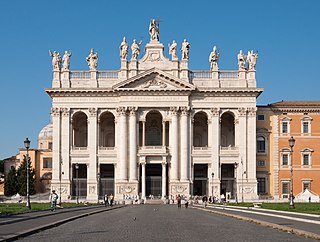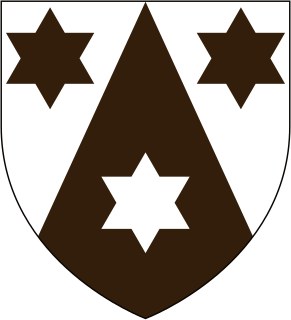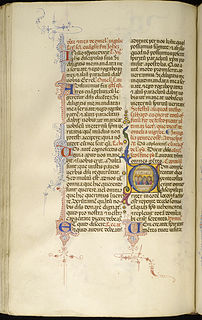It has been requested that the title of this article be changed to Catholic order liturgical rite . Please see the relevant discussion. The page should not be moved unless the discussion is closed; summarizing the consensus achieved in support of the move. |
A Catholic order liturgical rite is a variant of a Catholic liturgical rite distinct from the typical ones, such as the Roman Rite, but instead specific to a certain Catholic religious order.
In the Catholic Church, liturgy is divine worship, the proclamation of the Gospel, and active charity.

The Roman Rite is the main or Western liturgical rite of the Roman Catholic Church, the main particular church sui iuris of the Catholic Church. It is the most widespread liturgical rite in Christianity as a whole. The Roman Rite gradually became the predominant rite used by the Western Church, developed out of many local variants from Early Christianity on, not amounting to distinctive rites, that existed in the medieval manuscripts, but have been progressively reduced since the invention of printing, most notably since the reform of liturgical law in the 16th century at the behest of the Council of Trent (1545–63) and more recently following the Second Vatican Council (1962–65).
Contents
- Rites in the strict sense
- Rites in a broad sense (not distinct from the Roman Rite)
- Franciscan Rite
- Friars Minor Capuchin Rite
- Servite Rite
- References
Catholic order liturgical rites exist as variants of both Latin liturgical rites and Eastern liturgical rites, that is of both the Latin Church and the Eastern Catholic Churches, respectively.

Latin liturgical rites, or Western liturgical rites, are Catholic liturgical rites employed by the Latin Church, the largest particular church sui iuris of the Roman Catholic Church, that originated in Europe where the Latin language once dominated. Its language is now known as Ecclesiastical Latin. The most used rite is the Roman Rite.

The Latin Church, also known as the Western Church or the Roman Catholic Church, is the largest particular church of the Catholic Church, employing the Latin liturgical rites. It is one of 24 sui iuris churches, the 23 others forming the Eastern Catholic Churches. It is headed by the bishop of Rome, the pope – traditionally also called the Patriarch of the West – with cathedra in this role at the Archbasilica of Saint John Lateran in Rome, Italy. The Latin Church traces its history to the earliest days of Christianity, according to Catholic tradition, through its direct leadership under the Holy See.

The Eastern Catholic Churches or Oriental Catholic Churches, also called the Eastern-rite Catholic Churches, and in some historical cases Uniate Churches, are twenty-three Eastern Christian particular churches sui iuris in full communion with the Pope in Rome, as part of the worldwide Catholic Church. Headed by patriarchs, metropolitans, and major archbishops, the Eastern Catholic Churches are governed in accordance with the Code of Canons of the Eastern Churches, although each church also has its own canons and laws on top of this, and the preservation of their own traditions is explicitly encouraged. The total membership of the various churches accounts for about 18 million, according to the Annuario Pontificio, thus making up about 1.5 percent of the Catholic Church, with the rest of its more than 1.3 billion members belonging to the Latin Church, also known as the Western Church or the Roman Catholic Church.












